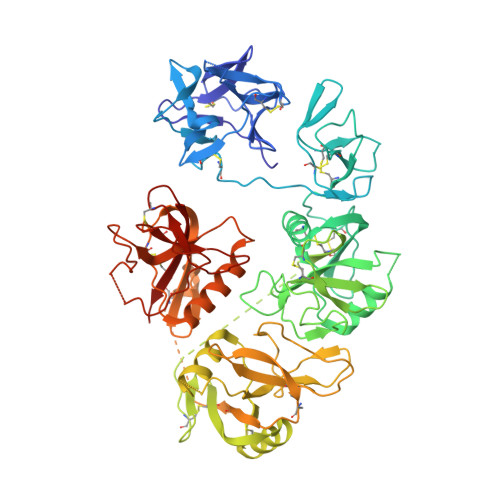Interaction of human dendritic cell receptor DEC205/CD205 with keratins.
Kong, D., Qian, Y., Yu, B., Hu, Z., Cheng, C., Wang, Y., Fang, Z., Yu, J., Xiang, S., Cao, L., He, Y.(2024) J Biological Chem 300: 105699-105699
- PubMed: 38301891
- DOI: https://doi.org/10.1016/j.jbc.2024.105699
- Primary Citation of Related Structures:
8HBC, 8K8H - PubMed Abstract:
DEC205 (CD205) is one of the major endocytic receptors on dendritic cells and has been widely used as a receptor target in immune therapies. It has been shown that DEC205 can recognize dead cells through keratins in a pH-dependent manner. However, the mechanism underlying the interaction between DEC205 and keratins remains unclear. Here we determine the crystal structures of an N-terminal fragment of human DEC205 (CysR∼CTLD3). The structural data show that DEC205 shares similar overall features with the other mannose receptor family members such as the mannose receptor and Endo180, but the individual domains of DEC205 in the crystal structure exhibit distinct structural features that may lead to specific ligand binding properties of the molecule. Among them, CTLD3 of DEC205 adopts a unique fold of CTLD, which may correlate with the binding of keratins. Furthermore, we examine the interaction of DEC205 with keratins by mutagenesis and biochemical assays based on the structural information and identify an XGGGX motif on keratins that can be recognized by DEC205, thereby providing insights into the interaction between DEC205 and keratins. Overall, these findings not only improve the understanding of the diverse ligand specificities of the mannose receptor family members at the molecular level but may also give clues for the interactions of keratins with their binding partners in the corresponding pathways.
- State Key Laboratory of Systems Medicine for Cancer, Shanghai Cancer Institute, Renji Hospital, Shanghai Jiao Tong University School of Medicine, Shanghai, China.
Organizational Affiliation:
















